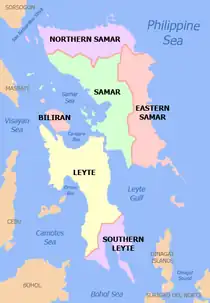Eastern Samar
Eastern Samar (Waray-Waray: Sinirangan Samar; Tagalog: Silangang Samar[3]), officially the Province of Eastern Samar, is a province in the Philippines located in the Eastern Visayas region. Its capital is the city of Borongan. Eastern Samar occupies the eastern portion of the island of Samar. Bordering the province to the north is the province of Northern Samar and to the west is Samar province. To the east lies the Philippine Sea, part of the vast Pacific Ocean, while to the south lies Leyte Gulf.
Eastern Samar
| |
|---|---|
| Province of Eastern Samar | |
.jpg.webp) 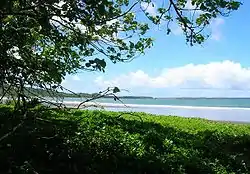 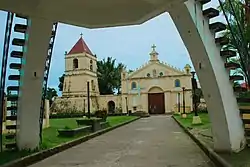 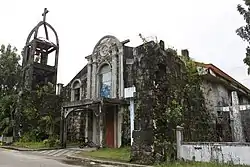   (from top: left to right) Port section of the Guiuan Integrated Transport Terminal, Baybay Boulevard in Borongan, Balangiga Church, Church of San Julian, Homonhon and Borongan Cathedral. | |
 Flag  Seal | |
 Location in the Philippines | |
OpenStreetMap | |
| Coordinates: 11°40′N 125°25′E | |
| Country | Philippines |
| Region | Eastern Visayas |
| Founded | June 19, 1965 |
| Capital and largest city | Borongan |
| Government | |
| • Governor | Ben P. Evardone (PDP–Laban) |
| • Vice Governor | Maria Caridad S. Goteesan (PDP–Laban) |
| • Legislature | Eastern Samar Provincial Board |
| Area | |
| • Total | 4,660.47 km2 (1,799.42 sq mi) |
| • Rank | 24th out of 81 |
| Highest elevation (Mount Mactaon) | 673 m (2,208 ft) |
| Population (2020 census)[2] | |
| • Total | 477,168 |
| • Rank | 60th out of 81 |
| • Density | 100/km2 (270/sq mi) |
| • Rank | 69th out of 81 |
| Divisions | |
| • Independent cities | 0 |
| • Component cities | 1 |
| • Municipalities | |
| • Barangays | 597 |
| • Districts | Legislative districts of Eastern Samar |
| Time zone | UTC+8 (PHT) |
| ZIP code | 6800–6822 |
| IDD : area code | +63 (0)55 |
| ISO 3166 code | PH-EAS |
| Spoken languages | |
| Highway routes | |
| Website | www |
History
Spanish colonial era
During his circumnavigation of the globe, Ferdinand Magellan had set foot on the tiny island of Homonhon in the southern part of the province. On March 16, 1521, the area of what is now Eastern Samar is said to be the first Philippine landmass spotted by Magellan and his crew.[4][5][6]
Philippine-American War
Maj. Eugenio Daza Area Commander of General Lukbán's forces for Southeastern Samar
Balangiga Encounter
On September 28, 1901, Filipino guerrillas led by Valeriano Abanador and Eugenio Daza in Balangiga ambushed American troops, killing 48 members of the US 9th Infantry. The incident triggered the infamous American retaliation March across Samar against the Samar populace and guerrillas.[6]
Japanese occupation era
In 1944, combined Filipino-American troops involved in the liberation of the Philippines from Japan built in the town of Guiuan the largest military base in the Pacific. In the same town in 1949, approximately 5,000 Russian refugees escaping from communist China temporarily settled on Tubabao Island until 1951, when they were transferred to Australia and the United States.[5]
Foundation
Eastern Samar, as a province, was created from Samar province through Republic Act No. 4221 on June 19, 1965.[7] Approved by Congress in 1963, it was authored by Samar congressmen Eladio T. Balite (1st district), Fernando R. Veloso (2nd district), and Felipe J. Abrigo (3rd district). The law, ratified in a plebiscite on June 19, 1965, divided Samar into three: Northern Samar, Eastern Samar and (Western) Samar.
Contemporary
Typhoon Haiyan (Yolanda), one of the strongest typhoons ever recorded, made its first landfall in the coastal town of Guiuan in November 2013.[8]
Geography
Eastern Samar covers a total area of 4,660.47 square kilometers (1,799.42 sq mi)[9] occupying the eastern section and majority of southern Samar's coast of Samar Island in the Eastern Visayas region. The province is bordered to the north by Northern Samar and to the west by Samar. To the east lies the Philippine Sea, part of the vast Pacific Ocean, while to the south lies Leyte Gulf.
Because it faces the Philippine Sea of the Pacific Ocean, Eastern Samar suffers heavily from powerful typhoons.[4]
Administrative divisions
Eastern Samar comprises 22 municipalities and one city, all encompassed by an lone congressional district and two provincial districts that elect a representative and provincial board members, respectively.
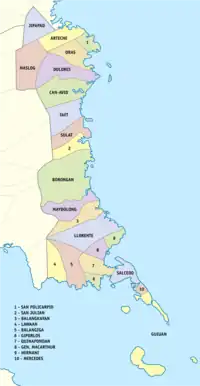
| |||||||||||||||||||||||||||||||||||||||||||||||||||||||||||||||||||||||||||||||||||||||||||||||||||||||||||||||||||||||||||||||||||||||||||||||||||||||||||||||||||||||||||||||||||||||||||||||||||||||||||||||||||||||||||||||||||||||||||||||||||||||||||||||||||||||||||||||||||||||||||||||||||||||||||||||||||||||||||||||||||||||||||||||||
Demographics
| Year | Pop. | ±% p.a. |
|---|---|---|
| 1903 | 79,645 | — |
| 1918 | 117,348 | +2.62% |
| 1939 | 154,347 | +1.31% |
| 1948 | 197,734 | +2.79% |
| 1960 | 237,747 | +1.55% |
| 1970 | 271,000 | +1.32% |
| 1975 | 287,149 | +1.17% |
| 1980 | 320,637 | +2.23% |
| 1990 | 329,335 | +0.27% |
| 1995 | 362,324 | +1.80% |
| 2000 | 375,822 | +0.79% |
| 2007 | 405,114 | +1.04% |
| 2010 | 428,877 | +2.10% |
| 2015 | 467,160 | +1.64% |
| 2020 | 477,168 | +0.42% |
| Source: Philippine Statistics Authority[10][11][11] | ||
The population of Eastern Samar in the 2020 census was 477,168 people,[2] with a density of 100 inhabitants per square kilometre or 260 inhabitants per square mile. The predominant language is Waray[6] and it is the main lingua franca of the entire island of Samar.
In the 2000 Census, Warays comprised 97.78% (366,787) of the total provincial population of 375,124 at that time. Kapampangan came second at 0.55% (2,067), Bisaya/Binisaya 0.43% (1,613), Cebuano at 0.18% (680), and Tagalog at 0.17% (621).[12]
Religion
The people of the province are devoted Christians where a majority adhere to Roman Catholicism.[6] The dominant Catholic faith influences the events of the provincial education, politics and social functions of the people. Other Christians usually form the remaining groups of believers such as the Born-again Christians, Protestants, Iglesia Filipina Independiente or Aglipayan church, Jehova's Witnesses, Iglesia ni Cristo, Baptists, Methodists, The Church of Jesus Christ of Latter-day Saints, and Seventh-day Adventists. Non Christians (mostly Muslims) are also found.
Transportation
The province has one operational airport; Borongan Airport located in the capital city. Currently, only Leascor operates out of Borongan Airport with flights weekly to serve locals and tourists to and from Cebu.

By land, mini buses and vans ply from the regional center in Tacloban, Catbalogan, and Calbayog in Samar province and to some towns in Eastern Samar. From Borongan, buses ply to Metro Manila. Motorized boats plies through Leyte Gulf ferrying passengers going to Tacloban City seaport.
Economy
Commercial activities in the province are centered on the provincial capital of Borongan while tourism activities are centered in Guiuan town where Calicoan Island and the historical Homonhon Island are located.[6] Generally, the province's major economic resource is fishery and agriculture which include production of coconut, copra, corn, rice, sugar, and vegetables.[6] Tourism potential is untapped on the northern part of the province.
References
- "List of Provinces". PSGC Interactive. Makati, Philippines: National Statistical Coordination Board. Archived from the original on 11 January 2013. Retrieved 13 April 2013.
- Census of Population (2020). "Region VIII (Eastern Visayas)". Total Population by Province, City, Municipality and Barangay. Philippine Statistics Authority. Retrieved 8 July 2021.
- "Mapa ng mga Wika (Rehiyon) - Rehiyon VIII" (in Tagalog). Commission on the Filipino Language. Retrieved 23 September 2021.
- Lancion, Jr., Conrado M.; cartography by de Guzman, Rey (1995). "The Provinces; Eastern Samar". Fast Facts about Philippine Provinces (The 2000 Millenium ed.). Makati, Metro Manila, Philippines: Tahanan Books. p. 72. ISBN 971-630-037-9. Retrieved 4 December 2015.
{{cite book}}: CS1 maint: multiple names: authors list (link) - Labro, Vicente S. (11 June 2011). "Guiuan's treasure chest of history, natural wonders". Philippine Daily Inquirer. Retrieved 24 April 2016.
- "The Province of Eastern Samar". National Statistical Coordination Board. Archived from the original on 6 December 2014. Retrieved 24 April 2016.
- Republic Act No. 4221 (19 June 1965). An Act Creating the Provinces of Northern Samar, Eastern Samar and Western Samar. Retrieved December 19, 2015.
- Baylis, Paul; Te-Ping Chen (22 November 2013). "How One Philippine Town Avoided Calamity". The Wall Street Journal. Retrieved 20 December 2015.
- "Province: Eastern Samar". PSGC Interactive. Quezon City, Philippines: Philippine Statistics Authority. Retrieved 8 January 2016.
- Census of Population (2015). "Region VIII (Eastern Visayas)". Total Population by Province, City, Municipality and Barangay. Philippine Statistics Authority. Retrieved 20 June 2016.
- Census of Population and Housing (2010). "Region VIII (Eastern Visayas)" (PDF). Total Population by Province, City, Municipality and Barangay. National Statistics Office. Retrieved 29 June 2016.
- "Eastern Samar: Home of the Warays; Table 4. Household Population by Ethnicity and Sex: Eastern Samar, 2000". Philippine Statistics Authority. 7 June 2002. Archived from the original on 16 November 2013. Retrieved 25 July 2016.
- "Poverty incidence (PI):". Philippine Statistics Authority. Retrieved December 28, 2020.
- "Estimation of Local Poverty in the Philippines" (PDF). Philippine Statistics Authority. 29 November 2005.
- "2009 Official Poverty Statistics of the Philippines" (PDF). Philippine Statistics Authority. 8 February 2011.
- "Annual Per Capita Poverty Threshold, Poverty Incidence and Magnitude of Poor Population, by Region and Province: 1991, 2006, 2009, 2012 and 2015". Philippine Statistics Authority. 27 August 2016.
- "Annual Per Capita Poverty Threshold, Poverty Incidence and Magnitude of Poor Population, by Region and Province: 1991, 2006, 2009, 2012 and 2015". Philippine Statistics Authority. 27 August 2016.
- "Annual Per Capita Poverty Threshold, Poverty Incidence and Magnitude of Poor Population, by Region and Province: 1991, 2006, 2009, 2012 and 2015". Philippine Statistics Authority. 27 August 2016.
- "Updated Annual Per Capita Poverty Threshold, Poverty Incidence and Magnitude of Poor Population with Measures of Precision, by Region and Province: 2015 and 2018". Philippine Statistics Authority. 4 June 2020.
External links
 Eastern Samar travel guide from Wikivoyage
Eastern Samar travel guide from Wikivoyage Media related to Eastern Samar at Wikimedia Commons
Media related to Eastern Samar at Wikimedia Commons Geographic data related to Eastern Samar at OpenStreetMap
Geographic data related to Eastern Samar at OpenStreetMap- Philippine Standard Geographic Code
- Local Governance Performance Management System
